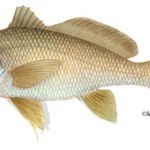Freshwater Drum:
The freshwater drum (Aplodinotus grunniens) is a silver-gray color on the sides with a white stomach. Their mouths point down. Drums have large eyes, a very high back, with a long dorsal fin with 24 – 32 rays and a rounded caudal fin. Skeletal features of freshwater drums are reinforced skull and unique ear bones, known as otoliths. These are large and round with an “L” on one of the flattened sides. People collect them on the water’s edge and consider them as “lucky stones.” Otoliths have been found at prehistoric archaeological sites, where they were perhaps used for decorations or for good luck charms to prevent sickness. Freshwater drums are sometimes confused with the carp, however the carp has barbels and a deeply forked tail.
Freshwater drums are native to Ohio, preferring habitats of deeper pools of rivers and in Lake Erie with clear water and clean bottoms. They spawn from April to late summer. Females will broadcast 100,000 to 500,000 eggs, which float on the water surface and hatch in one day. The fry are left to survive on their own.
Adult freshwater drums reach an average body length of twelve to thirty inches. In Lake Erie they will rarely get over twenty pounds. They may be larger in rivers. Adults feed on snails, mollusks, crayfish, aquatic insects and small fishes.
The drum has been abundant in Ohio since the 18th Century. Moravian missionary, David Zeisberger wrote that Indians would “commonly pierce this fish with an iron prong.” In the 1800s it was it was considered one of the most abundant fish in the Ohio and Mahoning Rivers.
Freshwater drums have been called a number of names including grunter and bubbler. American Indians called it the buffalofish because they grunted like a buffalo. Only breeding males make this sound. The drumming sound comes from muscles against the swim bladder. Today, local fishermen refer to the freshwater drum as silver or gray bass around the Ohio River and commonly known as sheepshead around Lake Erie.



